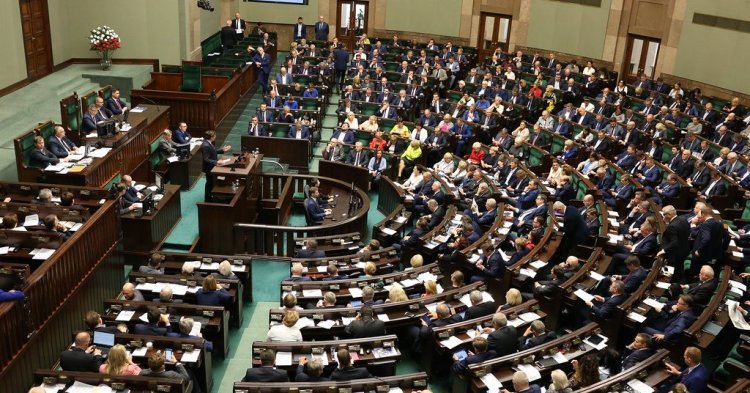WHAT is happening?
The ongoing constitutional crisis can be split into two main phases. The first phase was kicked off one month after the current government took power, in December 2015, and revolved around the Constitutional Court. The details of this phase is not the subject of this article, since it is largely complete, resulting in an almost total reshuffling of constitutional judges. Of the 15 seats, 13 have been appointed by the current government, 2 of which are former members of the Sejm who served as MPs for PiS (the Polish abbreviation for the Law and Justice Party) until the last election in 2019. Furthermore, the current chief judge was took part in secret meetings with the executive to discuss and possibly coordinate a response in regards to the issues arising from the second phase of the crisis. Therefore, the involvement of this new Constitutional Court in the ongoing crisis raises not only moral but also legal questions about its legitimacy.
The second phase, which is very much still in development, revolves around the Supreme Court and the judicial system as a whole. Mainly, this court is responsible for ruling on cases brought to it by appeals from lower courts. The origins of this second phase can be roughly traced back to a piece of legislation passed by the Sejm (the lower house of the Polish Parliament) on 20th July 2017. To summarise, the reforms that the government has been implementing had attacked the core democratic value of separation of powers by attempting to overhaul the top organs of the judiciary with a sudden change within its highest ranks. The main target of these reforms has been the Supreme Court, which has so far managed to stand its ground, but its future is unsecure.
WHY is this happening?
The official answer given by the government is largely threefold. It probably can be best summarised with snippets of a talk given by Prime Minister Mateusz Morawiecki at the New York University School of Law on the 30th of April 2019. Firstly, according to him, there is a historical justification: “In 1989 [...] the judiciary from the communist times became the judiciary in the new Poland. The same judges who have sentenced my brothers in arms [...] were building ‘independent’ and ‘objective’ judiciary of the III Republic of Poland during the 90’s”. Secondly, he highlighted that there was a need to change the way in which judges were selected, because the old method which delegated most of this power to the judiciary was not well equipped to deal with corrupt members since: “the system was self-replicating, and judges and the judiciary felt completely beyond any control”. As a result, the third argument calls for a more politicised selection (as is the case in the US) which could improve the “appallingly low” quality of the judiciary. Although these three arguments by no means show the whole range of explanations used by the government, they are the most representative and addressing them is essential.
The critics of the reforms argue that, while the points above may hold some truth, they do not justify carrying out reform in such a questionable manner. Additionally, there is more to all of the arguments outlined above than what the Prime Minister chose to emphasize. Firstly, after 1989, there were several avenues of lustration to which communist judges were subjected (a process undertaken in post-communist countries to clear the ranks of its administration from communist officials). As a result, many of them lost their positions during the transition. For example, only 19% of the Supreme Court judges were re-elected to their position to serve under the new democratic system in 1990. Still, many communist era judges who were known to give especially stringent punishments escaped justice. However, 30 years later, even if any of them slipped through and kept their jobs, there are almost none left still working.
As to the last two arguments presented by the government, the issue becomes a bit blurry. Critics largely agree with Morawiecki’s concerns about the appointment of judges, the so-called “closed loop”, may cause certain unaccountability. However, their main issue is not what the motivations of reforms are, but rather what the method is by which they are being carried out. Actions speak louder than words, and if we examine the actions of the government, some might question whether the aim is to address the issues outlined above, or the appointment of judges who are friendly towards the executive.
HOW is this happening?
The answer to this question might be the hardest to approach, as it involves many technicalities. I thus present a brief timeline of core developments.
September 2017 - The President proposes legislation to reform the judiciary after the Parliament fails to do so. It proposes the following changes in the Supreme Court: a) the creation of institutions within the Supreme Court which would handle complaints against judges, b) retiring with immediate effect judges who are over 65 years old (this was extended to the whole judiciary), c) changes in the method of selecting candidates for the Supreme Court.
The primary issue with these reforms revolves around point b) listed above, since it would have effectively sack 33% of all Supreme court judges with immediate effect, including the acting First President of the Supreme Court Malgorzata Gersdrof.
December 2017 - Despite criticism, the legislation passes the Sejm
June 2018 - The General Assembly of the Supreme Court ruling (the assembly of all Supreme Court Judges). All 63 judges of the General Assembly of the Supreme Court unanimously rule that, in accordance with the constitution, the First President of the Supreme will stay in power until the end of her official tenure in 2020. They also deliver the same verdict for the rest of the judges over 65.
This marks the beginning of the crisis in legal terms. In effect the Supreme Court overruled parliamentary legislation on constitutional grounds. This is also an indirect indication that in the view of the Supreme Court, the Constitutional Court failed in its duty. Namely, it did not sanction legislation which is not in accordance with the Constitution.
2nd August 2018 - The Supreme Court requests the European Court of Justice (ECJ) to review and rule on whether the controversial legislation is in accordance with EU law. At the same time, the Supreme Court declares that the Polish courts will not abide by this legislation until the ECJ has released its decision. This unprecedented move marks the deepening of the legal crisis. The latter was widely criticised as illegal by the executive, for example the Secretary of State of the President declared it a “circumnavigation of the law”.
24th June 2019 - ECJ final ruling - “the Court holds that the application of the measure lowering the retirement age of the judges of the Supreme Court to the judges in post within that court is not justified by a legitimate objective and undermines the principle of the irremovability of judges, that principle being essential to their independence.” The Polish government, although critical of the decision, acts in accordance with the ruling of the EJC, and suspends the 65 year retirement age.
31st January 2020 - The National Council of Judiciary (a complicated body established to review and nominate candidates for the highest judicial positions in Poland) released a list of candidates for new members of the Supreme Court. This list was only released after heavy media pressure, and presents a worrying picture. Most of the candidates are closely connected to the current government. Many of them recently worked in the Ministry of Justice, or had been lawyers of PiS.
As a sidenote, The National Council of Judiciary has long been criticised by the Polish media for its politicisation and closeness to the executive, and has been so far a strong instrument in the reforms.
4th February 2020 - The President signs legislation restricting judges from political engagement (dubbed by the critics as “muzzle law”) into law. It introduces disciplinary consequences for judges who are found to break this law.
February-March 2020 - Disciplinary cases against judges critical of reforms, and of the government in general, have been rolled out one by one, many of them by the Ministry of Justice.
A battle of interpretation
As seen above, although some of the issues raised by the government about potential problems with the old system have been accepted in a bipartisan way, the current developments raise uncomfortable questions for the executive. The continuous efforts to silence, persecute, and fire judges not aligned with the current political situation are becoming balder, especially since the parliamentary elections in 2019. Experts worry that a possible re-election of the current president in May 2020 might embolden the efforts of the government. In the meantime, it is feared that the institutions created within the Supreme Court to handle complaints against judges may be used as additional methods of intimidation. The problem with these institutions is also legal, since their existence is legally questionable, and thus their rulings are possibly void.
All in all, none of the sides involved are expected to budge from their positions. The government believes that their political mandate justifies their attempts to shape the judiciary. The opposition, on the other hand, points out that if done aggressively quickly and without consultation, such actions upset the basic democratic value of the separation of powers, which is a clear step towards an authoritative government.


Follow the comments: |
|
